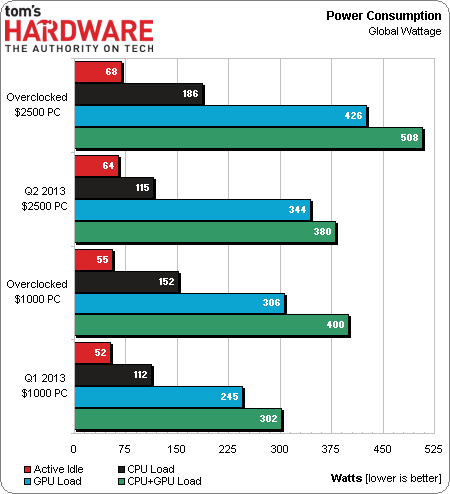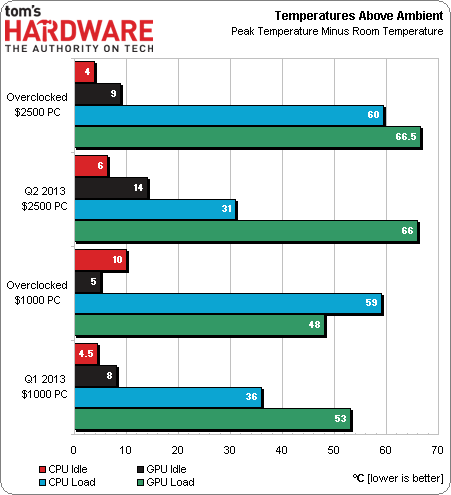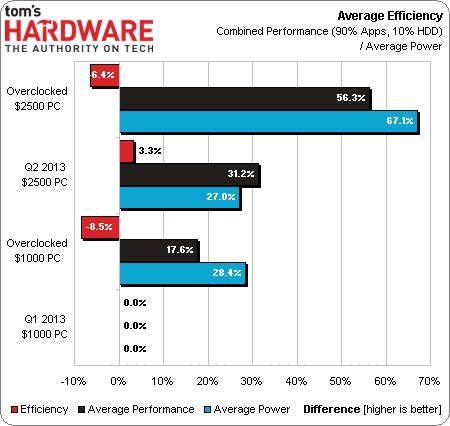System Builder Marathon, Q2 2013: $2500 Performance PC
Power, Heat, And Efficiency
My new build might cost 2.5 times as much as its predecessor, but that doesn’t mean it needs to pull twice the wattage from the wall. Since it doesn't even double the former machine's performance, I’m happy to see that its peak power draw is only around 26% higher.
Packing a GeForce GTX 690 into a so-called mini-ITX case, the temperatures chart is my chance to stick a finger in the eye of convention. When that convention is represented by Chris' former comments, enough said (Ed.: Hey, if you used a Titan you wouldn't have had to finagle that cooling setup!).
In Angelini’s defense, his statement referred to specific enclosures. But sticking to the "eye of convention" theme, it was really the front and side panel vents that made the difference. That is to say, the Tiki and Revolt he mentioned could have been designed to hold this card by simply placing case exhaust vents at both ends of the card's heat sink and an intake hole near its fan.
Efficiency compares work to power, but my data is presented in terms of work over time. That means I need to compare performance to power in order to rate my new system's comparative efficiency loss or gain. An 82% performance gain in games hints towards an efficiency victory, while a 1% difference in storage performance dampens my hopes slightly. I’m happy this time that storage counts towards only 10% of my total performance calculations.
The new system is more efficient than my previous build, but not by the margin I hoped. A 3% gain at stock speed and a smaller 6.4% loss when overclocked could almost be credited to the new build’s pricey 80 PLUS Platinum-rated power supply.
Get Tom's Hardware's best news and in-depth reviews, straight to your inbox.
Current page: Power, Heat, And Efficiency
Prev Page Results: File Compression Next Page I Fought The Law!-
sherlockwing Interesting $2500 MITX build, granted most people(including me) would have built a $2500 rig around 780 SLI in a ATX case.Reply -
burnley14 This just might be my favorite SBM ever, and this particular build my favorite machine of all time. Even if the relative value is slightly lower, many people including myself are willing to pay a small premium for a smaller footprint. Well done!Reply -
slomo4sho Seems I was pretty close in my initial guess:Reply
11002870 said:PCPartPicker part list / Price breakdown by merchant / Benchmarks
CPU: Intel Core i7-3770K 3.5GHz Quad-Core Processor ($319.99 @ Newegg)
CPU Cooler: Corsair H110 94.0 CFM Liquid CPU Cooler ($119.99 @ Newegg)
Motherboard: Asus P8Z77-I DELUXE/WD Mini ITX LGA1155 Motherboard ($207.55 @ Newegg)
Memory: Corsair Dominator Platinum 8GB (2 x 4GB) DDR3-2133 Memory ($149.99 @ Newegg)
Storage: Samsung 840 Series 500GB 2.5" Solid State Disk ($353.98 @ Newegg)
Storage: Western Digital Caviar Black 2TB 3.5" 7200RPM Internal Hard Drive ($159.99 @ Newegg)
Video Card: Asus GeForce GTX 690 4GB Video Card ($999.99 @ Newegg)
Case: BitFenix Prodigy (Black) Mini ITX Tower Case ($95.98 @ Newegg)
Power Supply: SeaSonic 660W 80 PLUS Platinum Certified ATX12V / EPS12V Power Supply ($148.54 @ Newegg)
Optical Drive: LG WH14NS40 Blu-Ray/DVD/CD Writer ($59.99 @ Newegg)
Total: $2597.99 -
agnickolov I wish the build had a 512GB SSD, but I understand the builder's value sentiment. The fast HDD is pure waste, however. A 2TB HDD can be found for under $100.Reply -
sarinaide Still struggling to get my mind on a high performance ITX system, to me its more a case of how much high end you can chuck into a psuedo M-ITX chassis which for all intents and purposes are not small form factor by any stretch of the imagination. Having owned a Prodigy they can hardly be said to be SFF when their total surface area is as much as a ATX chassis, it is like calling a HAF XB M-ITX.Reply
The main point of the article is that diminishing returns are high at that price point, only a overclocked system (again not a fan of in the confineds of a ITX system) give it value. -
csf60 I would take a 770 and water-cool that rig any day, but I suppose that's personal preference.Reply -
sarinaide It is safe to say that the purpose of the machine is gaming, for that is there any particular reason to go with the i7 other than to say you maxed the platforms highest capable chip but in terms of true benefits there is little over an i5 yet over a $100 been dropped on it. The next question is why not a GTX Titan, most of a 690 's performance but on less power and heat which is quite punishing in a Prodigy's confinds.Reply -
Crashman Reply
At the initialization's initiation, SFF meant "Shuttle Form Factor". The term has since been abused for everything from Micro ATX gaming cubes to book-sized PCs. Book-sized system builders would argue that Shuttle's fairly big traditional boxes aren't true SFF because they're too big, even though the term originally referred to these! If you remove the handles, this case is roughly the size of Shuttle's old 2-slot boxes (it's around 2 inches taller and 2 inches shorter in length)11028708 said:Still struggling to get my mind on a high performance ITX system, to me its more a case of how much high end you can chuck into a psuedo M-ITX chassis which for all intents and purposes are not small form factor by any stretch of the imagination. Having owned a Prodigy they can hardly be said to be SFF when their total surface area is as much as a ATX chassis, it is like calling a HAF XB M-ITX.
The main point of the article is that diminishing returns are high at that price point, only a overclocked system (again not a fan of in the confineds of a ITX system) give it value.
Gaming only? Then when the Core i7?11028926 said:It is safe to say that the purpose of the machine is gaming
Read pages 16 and 1711028926 said:is there any particular reason to go with the i7
Did you see the overclocking section? Three mediocre i5's in a row and i7 leads to O/C victory, in addition to the gains on pages 16 and 17.11028926 said:other than to say you maxed the platforms highest capable chip but in terms of true benefits there is little over an i5
Did you see a heat issue? I did not. Why would someone want to spend more money for less gaming performance? Or are you now saying that this is not a gaming PC?11028926 said:The next question is why not a GTX Titan, most of a 690 's performance but on less power and heat which is quite punishing in a Prodigy's confinds.





